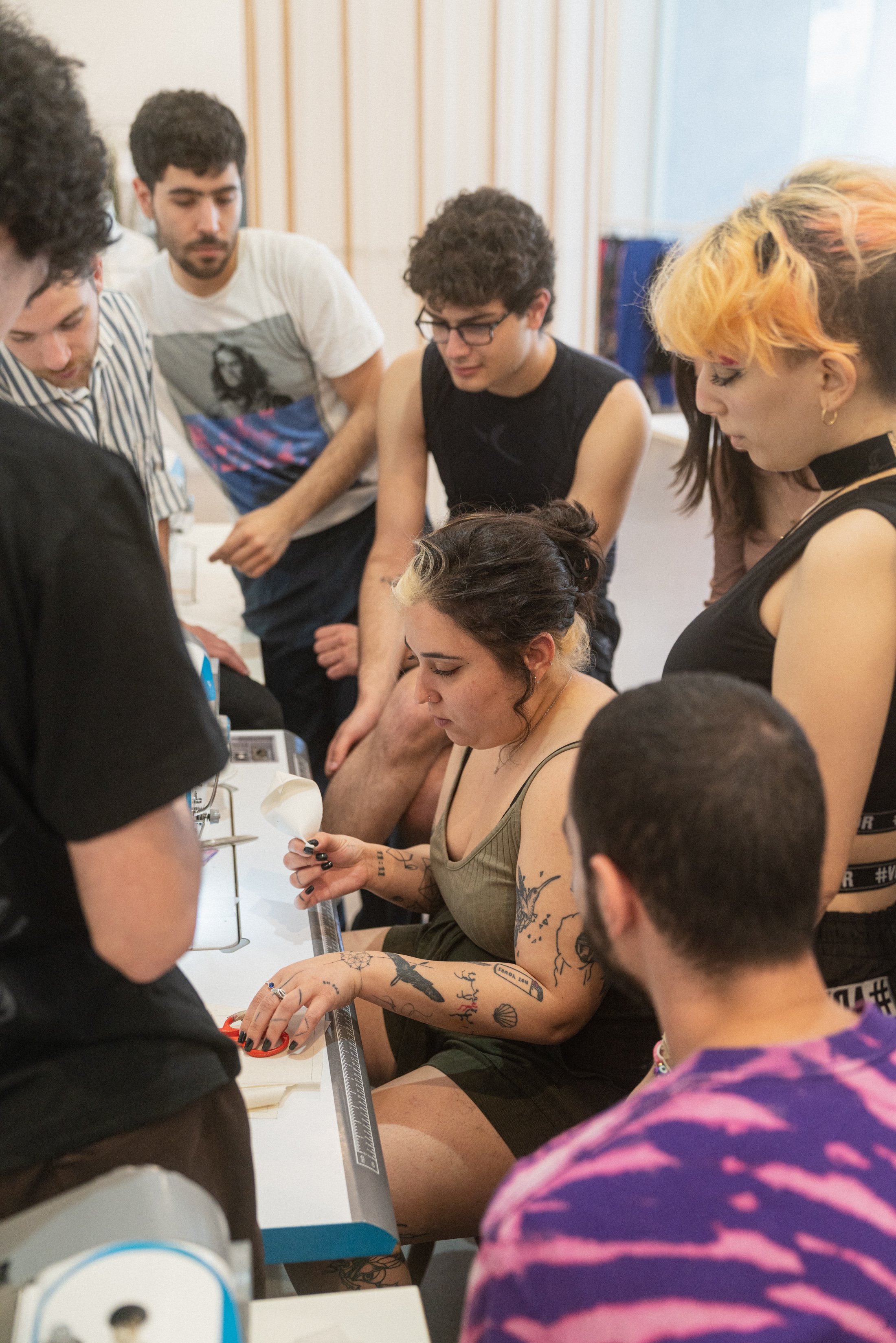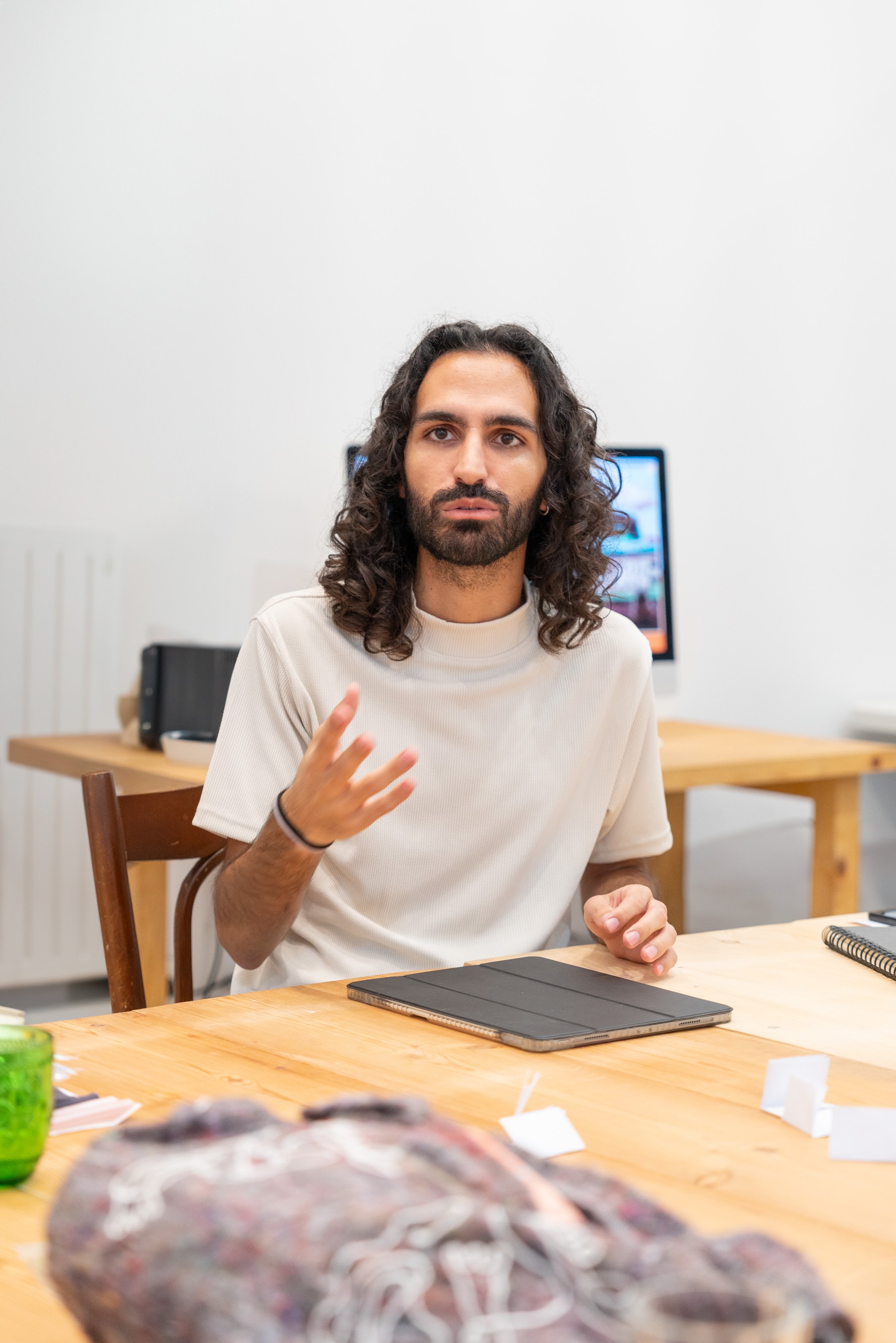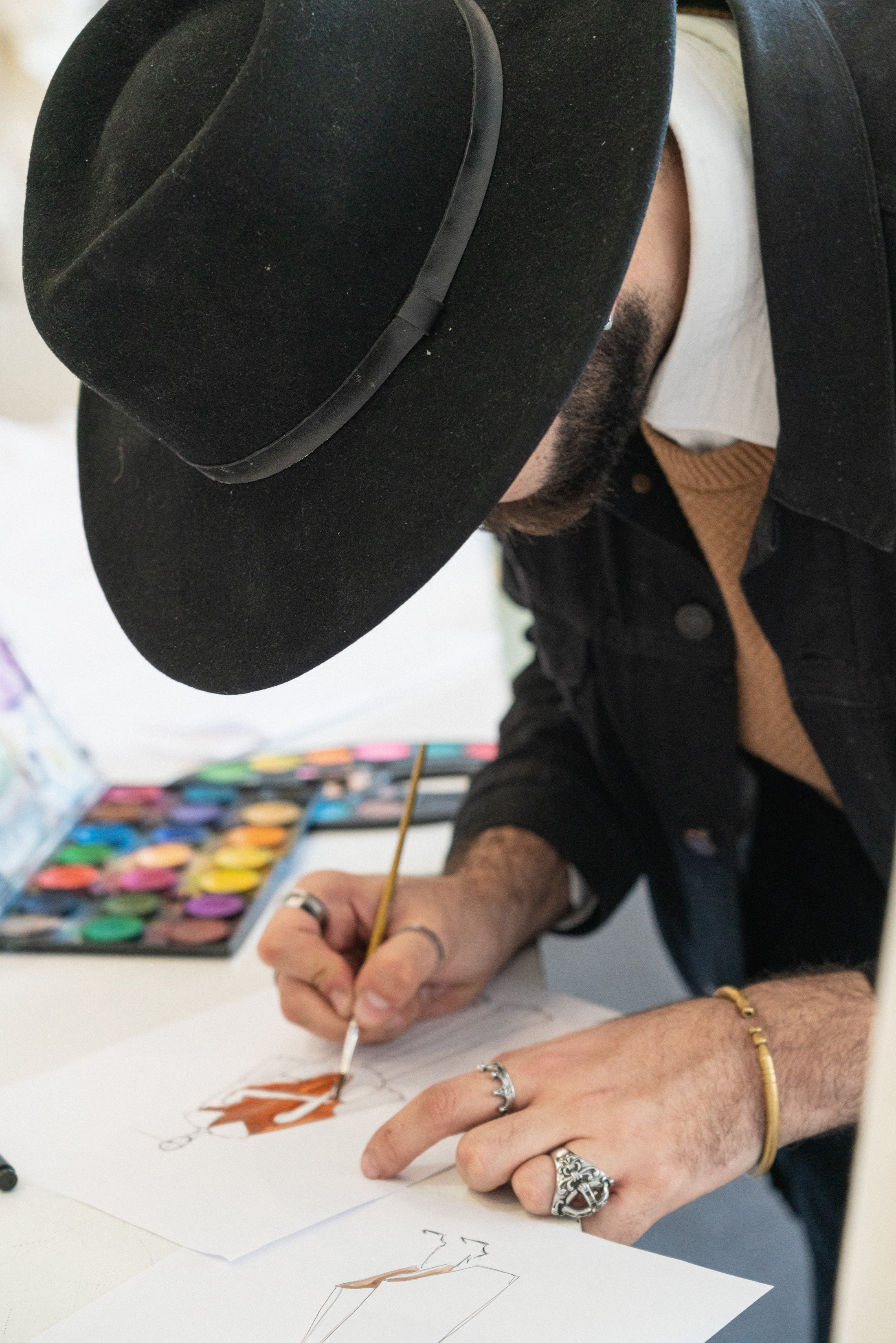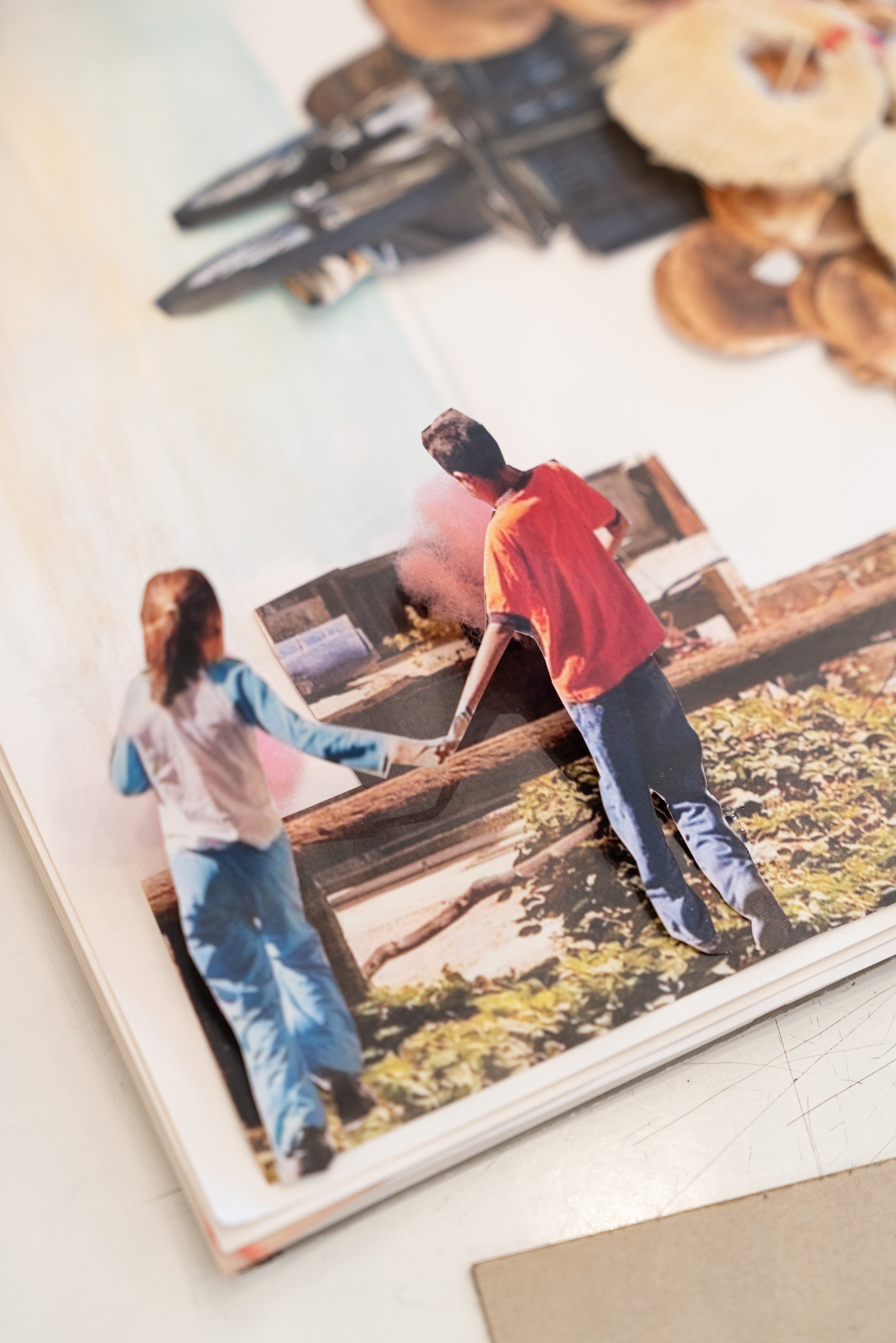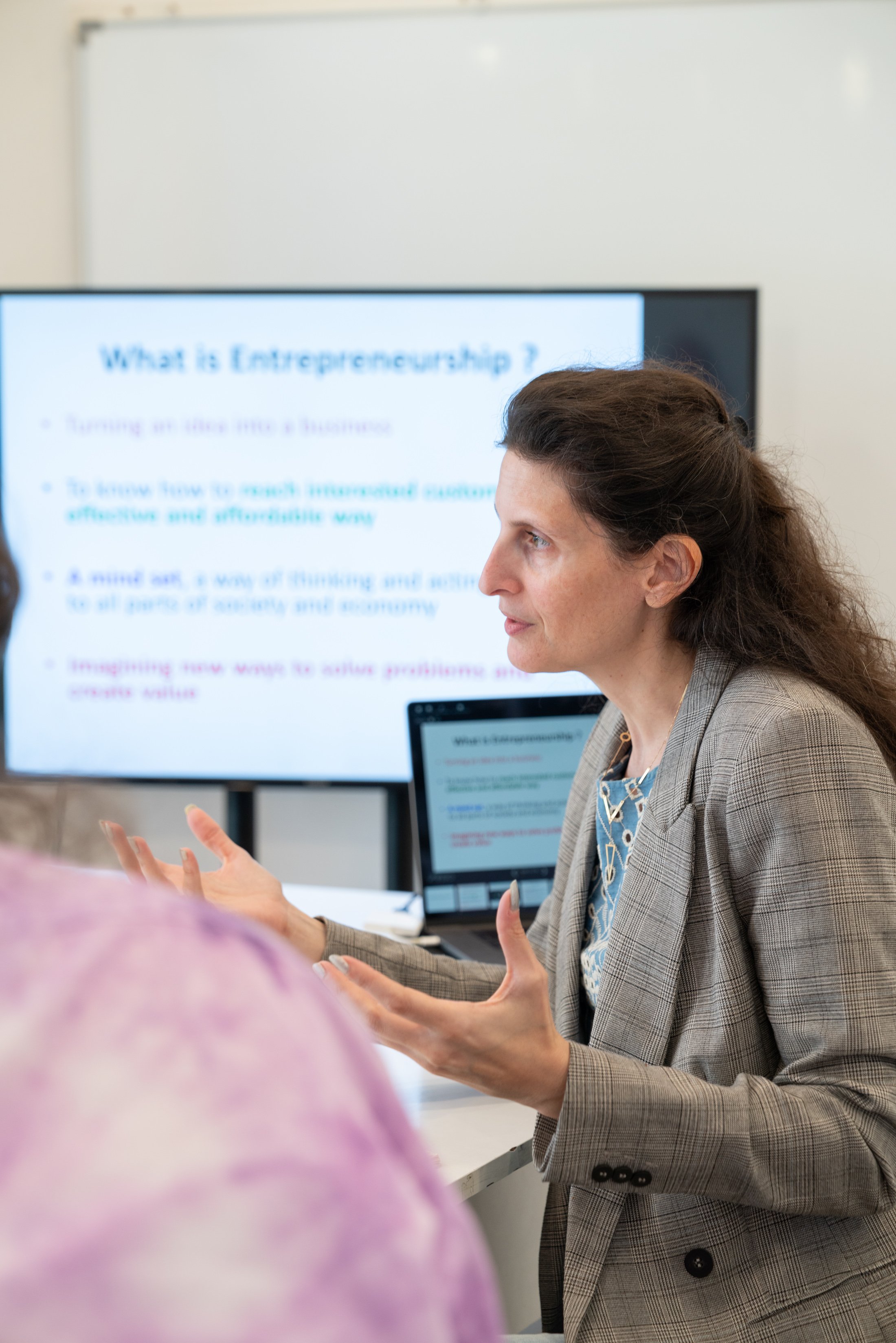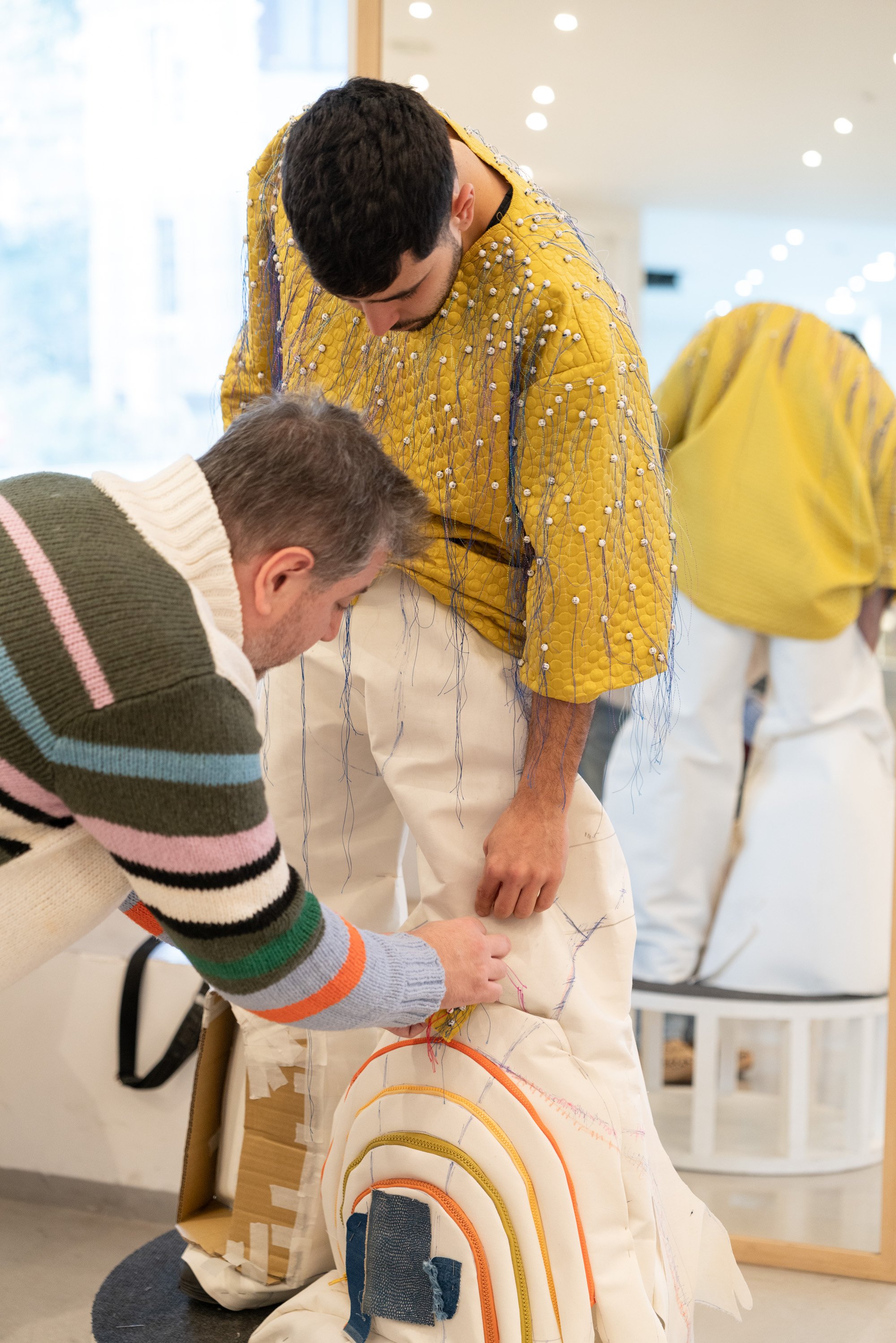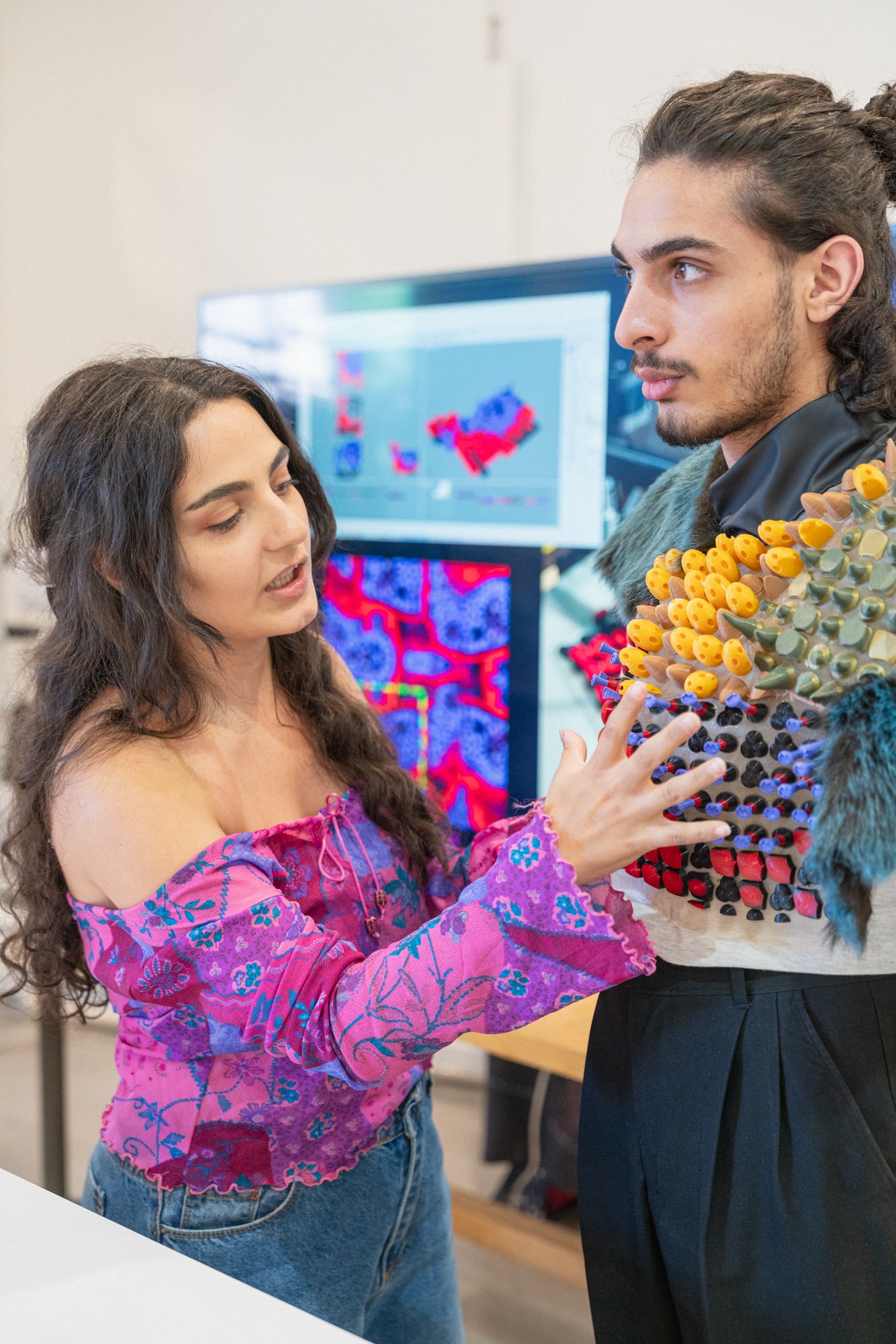Courses
YEAR ONE - FOUNDATIONS
Establishes a solid base in fashion design, introducing conceptual, technical, and digital design skills.
Semester One
Patternmaking I
Foundations
Introduces the fundamentals of pattern cutting and drafting, with a focus on skirt and shirt blocks. Students explore dart manipulation, pleating, and shaping techniques, developing a strong understanding of how two-dimensional patterns create three-dimensional forms. The course runs in tandem with Construction I, allowing for immediate application of techniques through sewn garments.
Construction I
Foundations
Covers the practical side of garment construction, emphasizing the use of industrial sewing machines and foundational techniques such as seam finishes, darts, and zipper installation. Students produce skirts and shirts from patterns developed in Patternmaking I, reinforcing the technical relationship between pattern cutting and construction.
Fashion Culture Studies I
Fashion as Cultural Expression
Covers the practical side of garment construction, emphasizing the use of industrial sewing machines and foundational techniques such as seam finishes, darts, and zipper installation. Students produce skirts and shirts from patterns developed in Patternmaking I, reinforcing the technical relationship between pattern cutting and construction.
Design Development I
Conceptual Foundations
Introduces students to the research-based design process, encouraging exploration of personal identity and conceptual thinking through mood boards, collages, and development spreads. Students begin to translate abstract ideas into design concepts while building a strong foundation in visual communication and portfolio development.
Fashion Illustration
Develops students’ ability to illustrate fashion concepts using diverse techniques and media. Coursework includes fabric rendering, gouache color mixing, fashion figure proportions, and live model drawing. Students build a personal illustration portfolio culminating in a final project based on original designs from Design Development I.
Surface Design I
Dyeing Techniques
Covers the practical side of garment construction, emphasizing the use of industrial sewing machines and foundational techniques such as seam finishes, darts, and zipper installation. Students produce skirts and shirts from patterns developed in Patternmaking I, reinforcing the technical relationship between pattern cutting and construction.
YEAR ONE - FOUNDATIONS
Semester Two
Patternmaking II
Streetwear
Builds on foundational patternmaking techniques with a focus on streetwear garments, including pants, tops, hoodies, and jackets. Students work with stretch and heavy fabrics like jersey and denim, adapting their approach to match the requirements of streetwear silhouettes. The course reinforces the connection between pattern development and construction, aligning closely with Construction II.
Construction II
Streetwear
Focuses on advanced garment construction techniques specific to streetwear. Students work on pants, t-shirts, hoodies, and jackets, refining their stitching, finishing, and assembly methods. Emphasis is placed on material handling, innovation, and sustainability, preparing students to produce well-finished garments that align with contemporary streetwear trends.
Design Development II
Streetwear & Solution-based design
Challenges students to translate concepts into wearable collections through two design projects: one focused on streetwear, and the other on functional, solution-based fashion. Emphasis is placed on research, problem-solving, and merging creativity with technical skills. Students create mood boards, sketches, and technical sheets, presenting their work to an external jury at the semester’s end.
Visual Communication I
Image, Storytelling & Photography
Introduces the basics of photography, composition, and art direction within the context of fashion. Students learn to operate cameras, use lighting creatively, and develop strong narrative concepts through mood boards and image recreation. The course builds foundational skills in visual storytelling that feed into advanced photography work in later semesters.
Digital Design I
Introduction to Digital Tools
Provides students with essential digital skills using Adobe Illustrator, Photoshop, and InDesign. Coursework includes creating technical flats, digital prints, mood boards, and professional presentations. Students apply these tools to finalize and present their streetwear designs in a cohesive digital portfolio.
Fabric Construction
Feltmaking, Basketry, Coiling, Weaving
Explores foundational and creative textile techniques through hands-on practice in felting, basketry, coiling, weaving, macramé, and crochet. Students learn to manipulate materials to create texture and structure while engaging with the cultural and historical relevance of each craft. The semester culminates in a final project integrating multiple techniques into a cohesive textile piece.
Creative Draping
The Caroline Simonelli Method
Introduces draping as a design method through the lens of CSB co-founder Caroline Simonelli’s signature approach. Students practice core techniques such as cowl draping, bias cutting, ruching, fluting, and structural experimentation. The course emphasizes silhouette creation and fabric manipulation, guiding students from draping to full garment construction through a final design project.
YEAR TWO - CRAFTMANSHIP
Advances into more complex design techniques, focusing on material exploration, refined construction methods, and design innovation.
Semester One
Patternmaking III
Outerwear
Focuses on advanced techniques in creating outerwear and structured garments. Students draft and develop patterns for jackets, trench coats, safari jackets, and boiler suits, exploring tailoring elements like collars, patch pockets, and complex closures. The course encourages both precision and creativity, offering space for experimental design within functional forms.
Construction IV
Tailoring
Centers on the construction of tailored garments using professional techniques such as canvas interfacing, pad stitching, and hand-finishing. Students construct jackets and trousers, gaining a deep understanding of the tailoring process while refining their skills in craftsmanship, precision, and material handling.
Design Development III
Exploring Personal Identity and Expression
Encourages students to explore their voice through concept-driven collections. Students experiment with new research methods, design ideation, and development strategies while translating themes of identity into wearable form. Portfolio presentation is a core component, allowing students to communicate their concepts with clarity and impact.
Digital Design II
Introduction to Digital Fashion
Introduces students to CLO3D and key Adobe tools for digital fashion development. Students learn to digitize design workflows—creating patterns, samples, line sheets, and pricing tools. Emphasis is placed on technical accuracy and presentation, with students producing digital content to support their collection development.
Visual Communication II
Fashion Photography
Provides hands-on experience in fashion photography, with a focus on storytelling, lighting, and direction. Students conceptualize and shoot fashion images, building technical skills in digital photography and post-production. The course culminates in a portfolio of editorial-style imagery that complements their design work.
Surface Design II
Embroidery and Fabric Manipulation
Explores embroidery and fabric manipulation as tools for design and storytelling. Students practice a wide range of techniques, including tambour, goldwork, smocking, quilting, and free-motion machine embroidery. Both hand and digital methods are used to develop personal motifs and textures that enrich textile surfaces.
YEAR TWO - CRAFTMANSHIP
Semester Two
Patternmaking IV
Tailoring
Focuses on advanced pattern drafting for bespoke tailored garments. Students explore both draping and flat-pattern methods to develop precise patterns for tailored jackets and trousers. Emphasis is placed on achieving structure, fit, and form through refined manipulation techniques and technical accuracy.
Construction III
Outerwear
Specializes in constructing various types of outerwear, with emphasis on tailoring finishes, structure, and functionality. Students build coats, jackets, and jumpsuits while mastering techniques such as sleeve assembly, interfacing, and precise detailing. The course reinforces professional finishing and strengthens the technical foundation for complex garments.
Fashion Culture Studies II
Heritage, Textile & Identity
Examines the intersections of fashion, culture, and identity through global and regional lenses, with a focus on the SWANA region. Students analyze how historical, political, and social contexts shape textile traditions and dress practices. Through case studies and discussions, the course engages with topics like heritage preservation, colonial influence, cultural appropriation, and fashion as a form of resistance and storytelling.
Visual Communication III
Branding
Explores the role of branding in fashion, focusing on the development of visual identity across physical and digital platforms. Students work on logo creation, typography, packaging, and campaign design, with attention to bilingual and multicultural communication. The course emphasizes storytelling through branding and prepares students to collaborate effectively with creative teams in industry contexts.
Collection Development
Supports students in finalizing the collections initiated in Design Development III. With guidance from instructors across design, surface, and construction, students refine each garment through fittings, experimentation, and fabric manipulation. The course culminates in a professionally presented collection, accompanied by a lookbook or editorial shoot, and presented to a final jury.
Corsetry and Couture
Offers a hands-on exploration of corsetry and couture design techniques. Students construct foundational corset forms and practice couture finishes such as beading, pleating, appliqué, and hand stitching. The course emphasizes structure, body contouring, and craftsmanship, connecting historical practices to contemporary expression.
Creative Space Beirut encourages peer-to-peer learning and creates individualized paths of study where students produce their own work under the mentorship of local and international artists and designers.
YEAR THREE - THESIS
Brings together all elements of the program in a comprehensive final collection while sharpening business, digital, and communication skills for industry readiness.
Semester One
Thesis Collection I
Defining the Vision
Marks the beginning of the final collection process, where students define and develop their design vision. Through one-on-one mentorship and workshops in design, construction, and surface development, students translate personal themes into a cohesive body of work. Emphasis is placed on research, storytelling, material sourcing, and iterative prototyping.
Business of Fashion I
Fundamentals
Introduces the core principles of launching and managing a fashion business. Students develop foundational skills in business planning, branding, budgeting, intellectual property, and market positioning. The course highlights ethical practices and transparency as essential pillars of a successful and socially responsible brand.
Surface Design III
Printmaking
Introduces three print and texture techniques—linoleum printing, weaving, and cyanotype—as tools for creative expression. Students explore each process through experimentation and concept development, using surface design to strengthen the visual narrative of their collections.
Makeup for Fashion
Blends foundational and editorial makeup skills with conceptual design. Students learn facial analysis, tools, and color theory before progressing into avant-garde, period, and runway techniques. The course emphasizes makeup as a complement to fashion storytelling, supporting both collection photoshoots and fashion presentations.
Grading
Workshop
An intensive four-week workshop focused on pattern grading for skirts, shirts, pants, and jackets. Students learn to scale garments across sizes while maintaining accuracy, fit, and design integrity. The course prepares students to create industry-standard graded patterns for diverse body types.
Visual Merchandising
Workshop
A one-week practical exploration of retail display and styling techniques. Students learn the principles of window and boutique presentation, working with light, layout, and garment styling. Each student creates a final visual merchandising concept around a selected piece from their collection.
YEAR THREE - THESIS
Semester Two
Thesis Collection II
Execution and Presentation
Brings the final collections to completion through advanced patternmaking, draping, and construction. Students focus on execution, material finishing, and visual communication. They develop lookbooks, photoshoots, and digital presentations, culminating in a final jury review and a professional showcase of their complete collection.
Business of Fashion II
Strategic Planning
An advanced course bridging fashion design and entrepreneurship. Students create comprehensive business plans that align with their final collections, including branding, financials, and market strategy. They explore sustainability, emerging technologies, and alternative business models, presenting their brand concept through a final pitch.
Surface Design IV
Knitting, Macramé, Weaving, Feltmaking
Expands students' practice in textile surface techniques, blending handcraft and experimental methods. Students explore the structure and cultural meaning of knitting, weaving, macramé, and feltmaking, producing innovative surfaces for use in collection development and textile-focused portfolios.
Through this progressive method, Creative Space Beirut has created a space that fosters dialogue between diverse students, nurtures their talent, and helps them turn their ambitions into solid skills while harnessing the ability to properly navigate their industry.
YEAR THREE- ELECTIVES
Electives offer specialized pathways for creative exploration, experimentation, and deepening of skills across digital, sustainable, and narrative disciplines.
Advanced Digital Fashion
IExpands on digital design using CLO3D and Connect, enabling students to create fully animated garments, avatars, and virtual presentations. Students develop dynamic digital assets for portfolios and social media, culminating in a virtual fashion show designed for immersive presentation on digital platforms.
Digital Fashion & Architecture
From Concept to Creation
Explores the intersection of digital fashion and spatial design through advanced tools such as 3D printing, laser cutting, and hybrid construction. Students prototype wearable concepts that blur boundaries between garment and architecture, bridging digital theory with physical experimentation.
Sustainable Fashion
Zero Waste Patternmaking & Upcycling
Immerses students in sustainability through zero-waste design and upcycling. Working with deadstock garments and fabric remnants, students develop new products with minimal environmental impact. The course culminates in a collaboration with a local boutique, where final pieces are showcased and sold.
Subversive Stitch
Embroidery as Protest and Survival
Explores embroidery as a medium for activism, resistance, and storytelling. Students study traditions like Chilean Arpilleras and Palestinian Tatreez, connecting textile practice to social justice movements. Through hands-on stitching, students develop personal narratives that culminate in a collaborative exhibition project.





